Negative regulation of NK cell functions by EAT-2, a sap-related adaptor expressed in innate immune cells
- Summary
- Abstract
- Description
- Claims
- Application Information
AI Technical Summary
Benefits of technology
Problems solved by technology
Method used
Image
Examples
example 1
Identification of ERT, a Novel Sap-Related Adaptor Expressed in Mouse NK Cells
[0175]During the process of analyzing the sequence of mouse eat-2 using public databases, a mouse cDNA sequence (accession number BB617320) that may encode a third member of the SAP family (FIG. 1a; data not shown) was discovered. The polypeptide translated from this cDNA, named ERT (for EAT-2-related transducer), is most closely related to EAT-2 (82% amino-acid identity). This homology extends to the SH2 domain and the carboxyl-terminal region. ERT is less similar to SAP (36% amino-acid identity). This is especially true for the carboxyl-terminal domain, which shows no conservation between EAT-2 / ERT and SAP. Examination of the mouse genomic database showed that the ert gene is located approximately 26 kilobases (kb) away from the eat-2 gene on chromosome 1 (FIG. 1b). Since ert exhibits the same exon-intron structure as eat-2 and sap, it likely represents a third member of the sap family.
[0176]To determine...
example 2
Enhanced NK Cell Functions in Mice Lacking EAT-2 or ERT, but not SAP
[0177]In the light of the close relationship between EAT-2 and ERT and since both are expressed in innate immune cells such as NK cells, the inventors decided to analyze the function of these two molecules in NK cells. For this purpose, mice lacking EAT-2 or ERT were generated by homologous recombination. After transfection of the constructs depicted in FIG. 2a in mouse embryonic stem (ES) cells, 129 / Sv mice homozygous for disruption of the eat-2 or ert gene were created (data not shown). Immunoblotting of NK cell lysates with an antibody specific against EAT-2 confirmed the lack of EAT-2 expression in eat-2− / − mice (FIG. 2b, first panel, lane 2). Similarly, immunoblotting of lysates with an antibody that recognized both ERT and EAT-2 demonstrated a striking reduction in the abundance of immunoreactive products in ert− / − animals (FIG. 2c, second panel, lane 2) (unfortunately, at the time of performing these experime...
example 3
Decreased NK Cell Functions in Transgenic Mice Overexpressing EAT-2 or ERT, but not SAP
[0182]To confirm these findings, the impact of enhanced expression of EAT-2 or SAP on NK functions (FIG. 4; FIG. 12) was also compared. A transgenic mouse approach was selected for this purpose, as mouse NK cells are poor recipient for transfection or retrovirus-mediated gene transfer. cDNAs coding for EAT-2 or SAP were cloned in a CD2 promoter-driven construct, and transgenic mice were created. Overexpression of EAT-2 or SAP was confirmed by immunoblotting of cell lysates with anti-EAT-2 (FIG. 4a, first panel) or anti-SAP (second panel), respectively.
[0183]First, natural cytotoxicity was examined (FIG. 4b; FIG. 12b). As expected from the enhanced responsiveness observed in eat-2− / − NK cells, augmented expression of EAT-2 suppressed the ability of NK cells to kill targets (FIG. 4b). Interestingly, this effect was broader than that observed with EAT-2 deficiency, as it concerned a wider range of ta...
PUM
| Property | Measurement | Unit |
|---|---|---|
| Fraction | aaaaa | aaaaa |
| Length | aaaaa | aaaaa |
| Biological properties | aaaaa | aaaaa |
Abstract
Description
Claims
Application Information
 Login to View More
Login to View More - R&D
- Intellectual Property
- Life Sciences
- Materials
- Tech Scout
- Unparalleled Data Quality
- Higher Quality Content
- 60% Fewer Hallucinations
Browse by: Latest US Patents, China's latest patents, Technical Efficacy Thesaurus, Application Domain, Technology Topic, Popular Technical Reports.
© 2025 PatSnap. All rights reserved.Legal|Privacy policy|Modern Slavery Act Transparency Statement|Sitemap|About US| Contact US: help@patsnap.com



